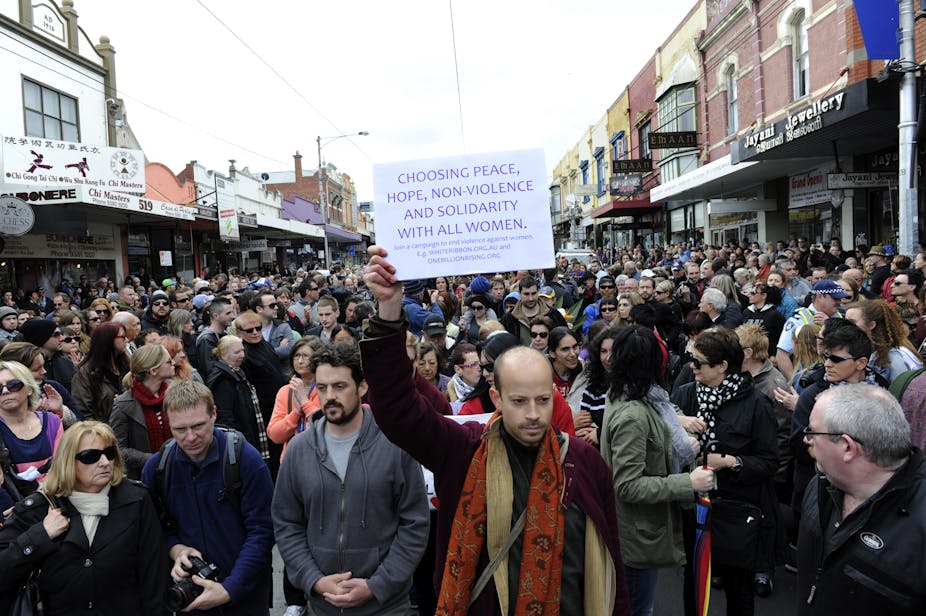The outpouring of emotion for murdered Irish woman Jill Meagher was intense and genuine. But why don’t we see similar displays for all female victims of violence?
In Melbourne, an estimated 30,000 people walked along Sydney Road Brunswick in what was presented as a “peace march” to honour the life of Jill Meagher, the victim of a horrific rape and murder. According to the organiser Philip Werner, the aim was to show support for “peace, hope, non-violence and solidarity with all women”.
While this was a remarkable event in many ways, notable for its scale, diversity and unprompted display of public grief, it was also a thoroughly depoliticised occasion, rendering ineffective any claim to genuinely challenge violence against women. It was a peace march with little reference, except in the most abstract sense, to the nature of the war it was opposing.
If violence against women is about power and domination and structural gender inequalities, then media representations of this recent murder have done a good job of disguising this fact. In a determined but understandable effort to avoid victim blaming, the social context of such crimes have been sadly overlooked. Variously depicted as “random” and an “extremely rare event”, or as being in the wrong place at the wrong time, gendered violence has been delinked from the social and cultural conditions that produce it.
To be fair, many participants on the “peace march” expressed unease about the confused messages here. Some felt that if it could happen to someone like Jill Meagher, then it could happen to them or to their daughters. Much discussion focussed on Melbourne being a very safe city for women. Yet, Victorian police statistics show a steady annual increase in reported rapes in recent years, including an 11.8 per cent increase in 2010-2011.
Melbourne is also a major international destination for women trafficked into sex slavery, according to a recent University of Queensland study. How can these legitimate personal concerns for women’s safety be reconciled with the wider social context of violence against women?
Would those marching in Melbourne on Sunday have been happy to extend their “solidarity with all women” and move to protest in front of the brothels in Richmond or South Melbourne that have been implicated in female trafficking? One assumes not, even though 30,000 people descending on these businesses could possibly have closed them down.
To others marching, this murder was interpreted as an affront to a celebrated unfettered individualism. Young women asserted their right to do anything they wanted to and to dress in any way they liked. This idea is one of the most dominant features of market individualism. The neo-liberal market promises that the self is a freely choosing agent, autonomous and unconstrained by social conditions.
Needless to say, this promise is illusory. In groups like Slutwalk which also aim to tackle the question of violence against women, this mainstream market ideology is writ large. Note for example placards at the Melbourne Slutwalk last year which read “If Madonna Can Wear It, So Can I.”
Language is important here. Yesterday, I was asked why I so strongly reject Slutwalk as a movement when I attended so many Reclaim the Night rallies in the past. The two are not the same. One taps into and celebrates the pornification of culture and the other does not. It is notable that in the “peace march” on Sunday, any reference to Slutwalk was significantly downplayed. Unlike the right to safety, the right to dress like Madonna is not in my view, a human right. Perhaps the recent ghastly events have stripped away many of our neo-liberal illusions.
We are left then with the difficult task of trying to rethink the way violence against women is represented, challenged and opposed. There used to be an overarching systemic concept that did this and it was called “patriarchy”. However, this concept is now considered somehow outmoded. Yet, threats to women’s safety are as ever-present, as they always have been. Any new conceptualisation would need to link patterns of gendered violence with so-called “random” events and also include the violence against less visible women, trafficked to cities like Melbourne.

